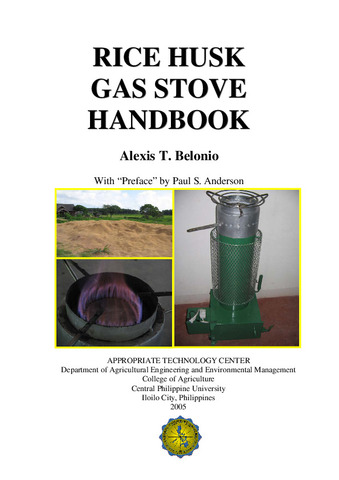Показать сокращенную информацию
Rice husk gas stove handbook
| dc.contributor.author | Belonio, Alexis T. | |
| dc.date.accessioned | 2021-02-13T09:39:41Z | |
| dc.date.available | 2021-02-13T09:39:41Z | |
| dc.date.issued | 2005 | |
| dc.identifier.citation | Belonio, A. T. (2005). Rice husk gas stove handbook. Jaro, Iloilo City: Central Philippine University. | en_US |
| dc.identifier.uri | https://hdl.handle.net/20.500.12852/370 | |
| dc.description | Full text | en_US |
| dc.description.abstract | Liquefied petroleum gas (LPG) is one of the conventional sources of fuel for cookstoves in the Philippines (Fig. 1). The use of LPG as source of fuel is common both in the urban and in the rural areas, particularly in places where its supply is readily accessible. The main reasons why LPG is widely adopted for household use are: it is convenient to operate, easy to control, and clean to use because of the blue flame emitted during cooking. However, because of the continued increase in the price of oil in the world market, the price of LPG fuel had gone up tremendously and is continuously increasing at a fast rate. At present, an 11-kg LPG, that is commonly used by common households for cooking, costs as high as P540 per tank (US$1 = PHP55) in urban areas or even higher in some places in rural areas. For a typical household, having four children, one LPG tank can be consumed within 20 to 30 days only depending on the number and amount of food being cooked. With this problem on the price of LPG fuel, research centers and institutions are challenged to develop a technology for cooking that will utilize alternative sources other than LPG. The potential of biomass as alternative fuel source to replace LPG is a promising option (7, 8). For the past years, gasifier stoves using wood as fuel has been developed in countries like the US, China, India, Thailand, Sri Lanka, and other developing countries in Asia. These gasifier stoves produce a flammable gas by burning the fuel with limited 16 2 amount of air. Wood gas stove was found promising to replace the conventional LPG stove. This stove has a minimal problem on carbon dioxide emission during cooking since it produces primarily carbon monoxide. However, with the problem on forest denudation facing the country combined with the need for fuel for cooking requirement, there is a need for us to look for alternative biomass fuel, other than wood, that can be used for cooking. | en_US |
| dc.format.extent | 155 leaves: illustrated (colored) | en_US |
| dc.language.iso | en | en_US |
| dc.publisher | Central Philippine University | en_US |
| dc.rights | CC0 1.0 Universal | * |
| dc.rights.uri | http://creativecommons.org/publicdomain/zero/1.0/ | * |
| dc.subject.ddc | CIR 665.776 B418 | en_US |
| dc.subject.lcsh | Rice hulls | en_US |
| dc.subject.lcsh | Stoves, Gas | en_US |
| dc.subject.lcsh | Biomass energy | en_US |
| dc.subject.lcsh | Renewable energy sources | en_US |
| dc.subject.lcsh | Biomass gasification | en_US |
| dc.subject.lcsh | Machine design--Handbooks, manuals, etc | en_US |
| dc.title | Rice husk gas stove handbook | en_US |
| dc.type | Book | en_US |
| dc.description.bibliographicalreferences | Includes bibliographical refences | en_US |
Файлы в этом документе
Данный элемент включен в следующие коллекции
-
Books [22]



